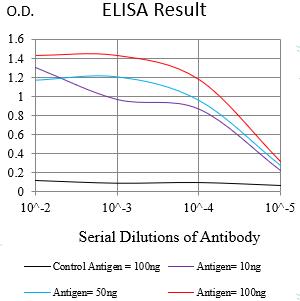
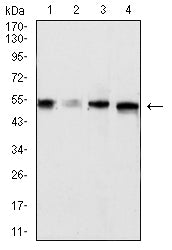
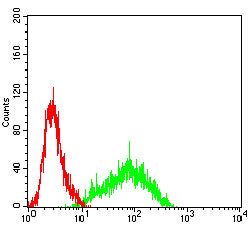
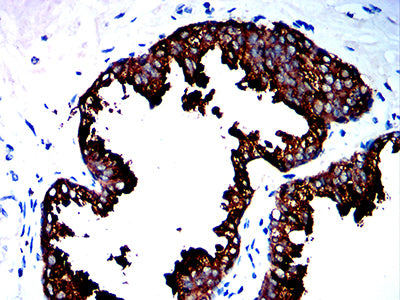
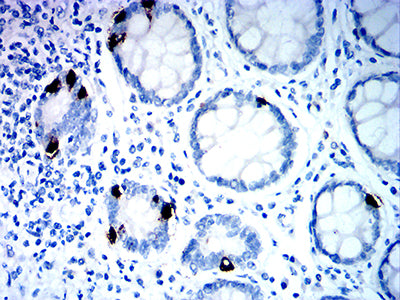
| WB | 1/500 - 1/2000 | Human,Mouse,Rat |
| IF | 咨询技术 | Human,Mouse,Rat |
| IHC | 1/200 - 1/1000 | Human,Mouse,Rat |
| ICC | 技术咨询 | Human,Mouse,Rat |
| FCM | 1/200 - 1/400 | Human,Mouse,Rat |
| Elisa | 1/10000 | Human,Mouse,Rat |
| Aliases | SAF2; SIGLEC-8; SIGLEC8L |
| Entrez GeneID | 27181 |
| clone | 1A5B9 |
| WB Predicted band size | 54kDa |
| Host/Isotype | Mouse IgG2b |
| Antibody Type | Primary antibody |
| Storage | Store at 4°C short term. Aliquot and store at -20°C long term. Avoid freeze/thaw cycles. |
| Species Reactivity | Human, Mouse, Rat |
| Immunogen | Purified recombinant fragment of human SIGLEC8 (AA: extra 17-216) expressed in E. Coli. |
| Formulation | Purified antibody in PBS with 0.05% sodium azide |
+ +
以下是关于SIGLEC8抗体的3篇文献概览(基于公开研究进展整理):
---
1. **文献名称**:*Targeting Siglec-8 for the Treatment of Eosinophilic Gastritis: A Preclinical and Clinical Study*
**作者**:Bochner BS 等
**摘要**:研究报道了抗SIGLEC8抗体(如AK002)通过诱导嗜酸性粒细胞凋亡和抑制肥大细胞活化,显著降低嗜酸性胃炎患者的组织嗜酸性粒细胞计数,并在I/II期临床试验中展示安全性及潜在疗效。
2. **文献名称**:*Siglec-8 Antibody Inhibits Mast Cell Activation in Chronic Urticaria Models*
**作者**:Youngblood BA 等
**摘要**:该文献通过体外实验和小鼠模型证明,抗SIGLEC8抗体可特异性结合肥大细胞表面受体,抑制其脱颗粒和炎症介质释放,为慢性自发性荨麻疹的治疗提供了新机制依据。
3. **文献名称**:*Siglec-8 as a Therapeutic Target for Allergic Diseases: Mechanisms and Clinical Prospects*
**作者**:Kiwamoto T 等
**摘要**:综述文章总结了SIGLEC8在过敏性疾病中的调控作用,强调其抗体通过双重靶向嗜酸性粒细胞和肥大细胞的独特优势,并讨论了当前临床试验(如哮喘、特应性皮炎)的进展与挑战。
---
注:以上内容基于领域内代表性研究方向整合,若需具体文献全文或细节,建议通过PubMed或期刊数据库检索关键词“SIGLEC8 antibody”。
SIGLEC8 (sialic acid-binding immunoglobulin-type lectin 8) is a cell surface receptor predominantly expressed on eosinophils, mast cells, and a subset of basophils. As a member of the SIGLEC family, it recognizes sialylated glycans and plays a role in modulating immune cell activity. Its cytoplasmic domain contains immunoreceptor tyrosine-based inhibitory motifs (ITIMs), enabling it to transmit inhibitory signals that regulate cell activation, survival, and effector functions. In eosinophils, SIGLEC8 engagement promotes apoptosis and suppresses inflammatory mediator release, while in mast cells, it inhibits IgE-mediated degranulation.
SIGLEC8 has emerged as a therapeutic target for eosinophil- and mast cell-driven diseases, such as severe asthma, chronic urticaria, eosinophilic gastrointestinal disorders, and mast cell activation syndromes. Antibodies targeting SIGLEC8 are designed to exploit its inhibitory signaling or induce targeted cell depletion. For example, agonistic antibodies that crosslink SIGLEC8 can trigger eosinophil apoptosis or suppress mast cell hyperactivity. Conversely, antibody-dependent cellular cytotoxicity (ADCC)-enhanced antibodies may directly eliminate pathogenic cells.
Preclinical studies demonstrate that SIGLEC8-targeting antibodies reduce tissue eosinophilia and mast cell-mediated inflammation. Several candidates are in clinical development, offering potential precision therapies for diseases with limited treatment options. By selectively targeting pathogenic cells while sparing broader immune functions, SIGLEC8 antibodies aim to achieve efficacy with reduced systemic toxicity compared to conventional immunosuppressants.
×